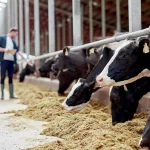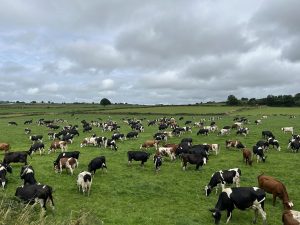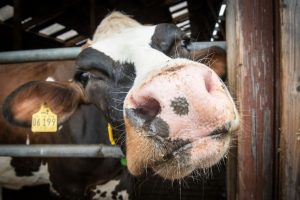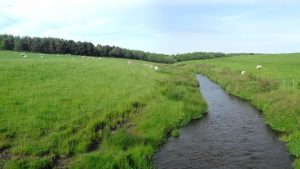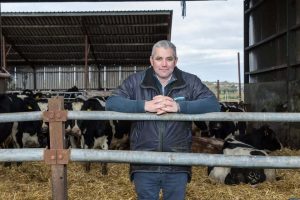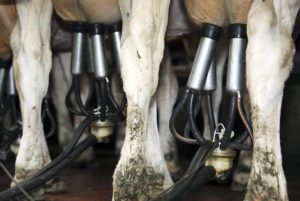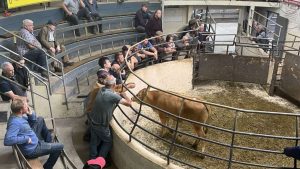
The last six months have been one of the most seismic periods in the recent history of Irish agriculture, especially the dairy sector, as the nitrates derogation saga unfolded.
Come January 1, the maximum organic nitrogen (N) stocking rate under the derogation will fall from 250kgN/ha to 220kgN/ha in most of the country.
This has left many dairy farmers in a very uncertain position for 2024 and beyond, with farmer representatives and rural TDs fearing significant income losses.
This is to say nothing of knock-on effects in other sectors, particularly tillage, with dairy farmers’ requirements for more land putting pressure on land prices.
Although the issue can be traced back to early 2022 when the European Commission granted Ireland a nitrates derogation up to 2026 – which included the condition that the derogation would be reduced to 220kg/ha in areas where water quality was poor or not improving – the last six months have seen the most important developments.
The ‘red map’
The easiest place to start is, conveniently enough, the exact mid-point of the year – June 30 – when the Environmental Protection Agency (EPA) delivered a report on water quality, in line with the derogation conditions.
The EPA also showed a map – which came to be known as the ‘red map’ – to stakeholders outlining which areas of the country would see the derogation reduced.
Farm organisations responded to this development with alarm, calling on Minister for Agriculture, Food and the Marine, Charlie McConalogue to highlight the measures that farmers take on water quality to the European Commission.
In early July, the minister said he would seek flexibility from the commission to offset the impact of the derogation cut, for some farmers at least.
It emerged in mid-July that, in an effort to seek that flexibility, the minister asked farm organisations for their views on how to approach the commission on the issue.
Later in July, the IFA held a rally to highlight the impact of the derogation cut at Kilkenny Mart, attended by roughly 1,000 farmers.
The issue reached the floor of the Dáil and Seanad, with many rural TDs and senators highlighting the threat to farmer incomes; for example, independent TD Michael Healy-Rae said the derogation cut was an “attack on Irish dairy farmers”.
Nitrates derogation bombshell
In early-September, Minister McConalogue held a video call with European Commissioner for the Environment, Virginijus Sinkevicius, for crunch talks to seek changes or flexibilities.
The result of the meeting was a bombshell. The commissioner ruled out the possibility of revising or changing any part of the already-agreed conditions on Ireland’s nitrates derogation, essentially confirming that the derogation cut would go ahead in the new year.
This was immediately followed by calls from the Irish Farmers’ Association (IFA) for the Taoiseach to intervene with the commission on the matter, while the Irish Creamery Milk Suppliers’ Association accused the government of “abject surrender” on the derogation.
On the same day, the minister attended the Agricultural Science Association (ACA) Conference 2023, where he told journalists he had been “disconcerted around the complacency” towards the derogation by some agriculture sector stakeholders.
Shortly after, the IFA announced their intention to protest at the Fianna Fáil and Fine Gael party conferences – or ‘think-ins’.
At the Fianna Fáil think-in on September 11 in Co. Tipperary, an IFA delegation – including association president Tim Cullinan – met with Minister McConalogue and Tánaiste Micheál Martin for what Cullinan called a “heated debate” which resulted in no significant outworkings.
Around this time, Irish MEP Colm Markey said that, after a meeting with Commissioner Sinkevicius, the commissioner was open to a “way forward” that might avoid a large cull of dairy cows and that would be consistent with Ireland’s obligations under the derogation conditions agreed in 2022.
The commissioner also had a virtual meeting with the Joint Oireachtas Committee on Agriculture, Food and the Marine in early-September.
On foot of this meeting, Minister McConalogue came under fire from Senator Tim Lombard, who said that the minister’s comments – reflecting an attitude that the matter was definitively closed – did not tally with the commissioner’s comments to the committee that there may be some wriggle room outside of the derogation terms and conditions that could limit the worst of the derogation impact.
Despite this, the minister ruled out re-engaging with the commission on the derogation, and persistently highlighted the importance of focusing on retaining a nitrates derogation after 2025.
Meanwhile, the IFA’s protest at the Fine Gael think-in in Limerick city on September 15 was somewhat more constructive than its protest at Fianna Fáil’s.
When Tim Cullinan met with Taoiseach Leo Varadkar and other Fine Gael ministers, the Taoiseach agreed to invite Commissioner Sinkevicius to Ireland for a meeting with government and stakeholders (however, it emerged shortly afterwards that Minister McConalogue had already extended a similar invitation to the commissioner).
The nitrates derogation was the talk of Ratheniska, Co. Laois when the 2023 National Ploughing Championships took place there from September 19 to 21.
Minister McConalogue spoke on the first day of the event on Agriland’s Ploughing livestream (Agriland being the event’s official livestream partner), where he again reiterated that the “big battle” is to retain the derogation after 2025, saying that the 220kgN/ha limit is higher than what the commission had initially sought when the current derogation was agreed in early 2022.
In early October came a rare, albeit small, positive development in all this: The final version of the ‘red map’ that would be used to determine which areas of the country would see the derogation reduced indicated that a slightly smaller area of the country – and a slightly smaller number of farmers – would be impacted than originally thought.
The ‘red’ area of the map was 6% smaller than the corresponding area in the original EPA map from June, with some 230 less farmers being impacted as a result.
A week later, Budget 2024 was announced, which included an increased level of grant aid for farmers constructing or increasing slurry storage capacity, in anticipation of dairy farmers impacted by the derogation needing to offload significant amounts of slurry.
In early-November, it was confirmed that Commissioner Sinkevicius had accepted the Taoiseach’s invitation to come to Ireland, and would be visiting on November 23.
Around that time, a delegation from the IFA met with the commissioner to outline the pressure that the impacted farmers would face by the derogation cut. The meeting seemed to be a positive one, with the IFA saying that the commissioner “wants to be helpful”.
Commissioner comes to town
The commissioner arrived in Ireland on November 23 for what turned to be a shorter visit than might have been hoped, with no farm visit scheduled.
There had been some hope that some flexibilities and measures could be agreed, outside of the derogation conditions, that would ease the impact. However, the visit of the commissioner left stakeholders disappointed; nothing new was agreed, and nothing in the way of additional flexibilities was announced, essentially rubber stamping the move to 220kgN/ha in the ‘red’ areas.
The visit of Commissioner Sinkevicius seemed to resign stakeholders to the fact that securing the derogation after 2025 through improving water quality, rather than seeking ways to offset the impact of the impending reduction in January, would have to be the focus when it came to engagement with the European Commission.
It became clear that trying to offset the impact of the cut would have to be tackled within Ireland, with government highlighting the importance of slurry exports.
European Commissioner Mairead McGuinness told the Guild of Agricultural Journalists that she was confident Ireland could secure the derogation (albeit at 220kgN/ha) when she delivered the guild’s Michael Dillon Memorial Lecture on November 24.
On December 4, Minister for Enterprise, Trade and Employment Simon Coveney, told the Sustainable Dairy Future Conference at University College Cork (UCC) that a “significant collective effort” would be needed to avoid “dramatic decisions” to cull cows, again stressing the government view that exporting slurry is a key way forward.
Also in early December, Minister McConalogue was called on by the ICMSA to deliver flexibilities “within his gift”.
These include, among others, delaying the onset of the derogation cut; disregarding the first 100 days of a calves life; and reviewing the N content of slurry (which the ICMSA believes hampers slurry exports).
That week, Taoiseach Leo Varadkar told the Dáíl that his “biggest concern” remains the potential loss of the derogation altogether after 2025 if water quality doesn’t improve.
Nitrates derogation into 2024
After the last six months, 2024 is looking uncertain for dairy farmers that farm above 220kgN/ha.
However, the net outcome and effect of the last half-a-year is unlikely to be known for some time, with the potential that, with sufficient capacity for slurry storage and exports, and other potential mitigation measures, the impact can be offset.
Either way, all the developments on the nitrates derogation into 2024 and beyond can be followed here on Agriland.

